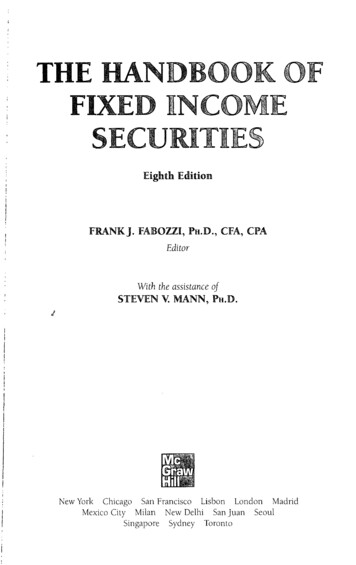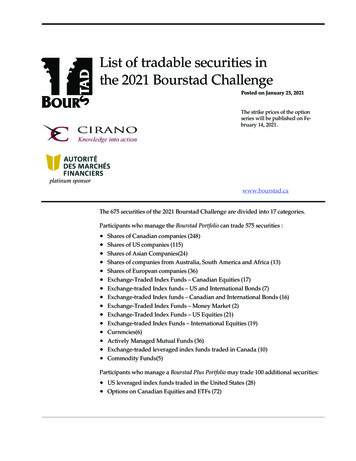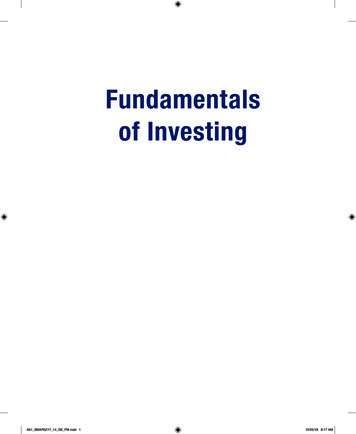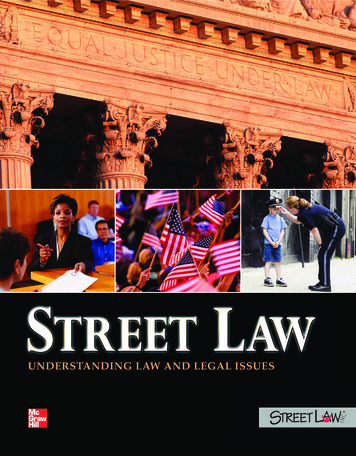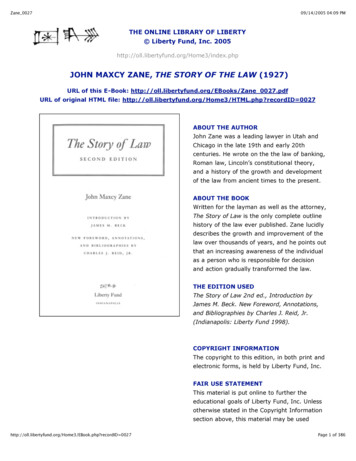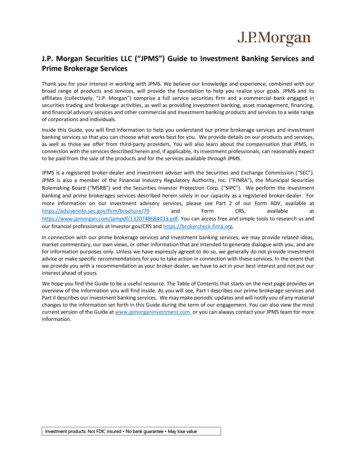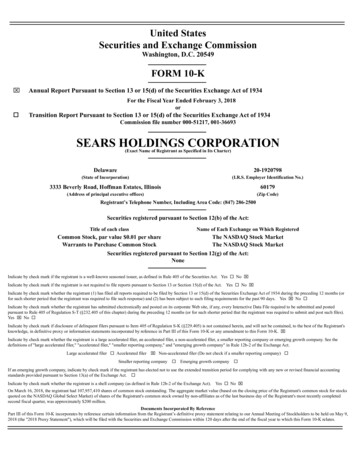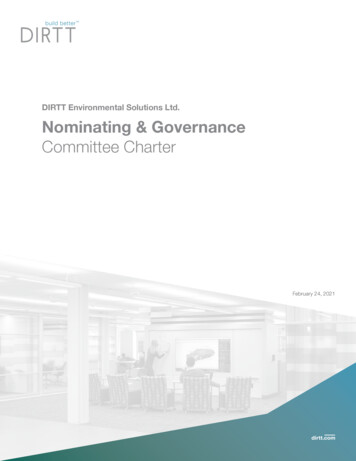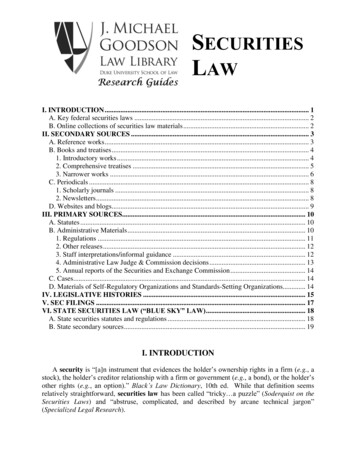
Transcription
SECURITIESLAWI. INTRODUCTION . 1A. Key federal securities laws . 2B. Online collections of securities law materials . 2II. SECONDARY SOURCES . 3A. Reference works . 3B. Books and treatises . 41. Introductory works . 42. Comprehensive treatises . 53. Narrower works . 6C. Periodicals . 81. Scholarly journals . 82. Newsletters . 8D. Websites and blogs. 9III. PRIMARY SOURCES. 10A. Statutes . 10B. Administrative Materials . 101. Regulations . 112. Other releases . 123. Staff interpretations/informal guidance . 124. Administrative Law Judge & Commission decisions . 135. Annual reports of the Securities and Exchange Commission . 14C. Cases. 14D. Materials of Self-Regulatory Organizations and Standards-Setting Organizations. 14IV. LEGISLATIVE HISTORIES . 15V. SEC FILINGS . 17VI. STATE SECURITIES LAW (“BLUE SKY” LAW) . 18A. State securities statutes and regulations . 18B. State secondary sources . 19I. INTRODUCTIONA security is “[a]n instrument that evidences the holder’s ownership rights in a firm (e.g., astock), the holder’s creditor relationship with a firm or government (e.g., a bond), or the holder’sother rights (e.g., an option).” Black’s Law Dictionary, 10th ed. While that definition seemsrelatively straightforward, securities law has been called “tricky a puzzle” (Soderquist on theSecurities Laws) and “abstruse, complicated, and described by arcane technical jargon”(Specialized Legal Research).
The purpose of this guide is to help researchers navigate this complex area of law by identifyinghelpful print and online sources for securities law research available through the Goodson LawLibrary. These materials include key primary sources, secondary sources, collections of legislativehistory documents, and tools for searching securities filings. The main focus of this guide is federalsecurities law, but information about selected primary and secondary sources for state securitieslaw (“Blue Sky” law) research appears in section VI.A. Key Federal Securities LawsSeveral New Deal era securities acts passed in response to the 1929 stock market crashestablished the statutory framework of federal securities law, which (as amended) still operatestoday. Researchers will find, therefore, that secondary sources and collections of primary sourcesare often organized by the act to which they relate. As outlined in many treatises, these key federalsecurities laws include the following acts: the Securities Act of 1933 (also known as the “1933 Act,” the “33 Act,” or the “SecuritiesAct”), ch. 38, 48 Stat. 74 (codified as amended at 15 U.S.C. §§ 77a et seq.);the Securities Exchange Act of 1934 (also known as the “1934 Act,” the “34 Act,” or the“Exchange Act”), ch. 404, 48 Stat. 881 (codified as amended at 15 U.S.C. §§ 78a et seq.);the Trust Indenture Act of 1939, ch. 411, 53 Stat. 1149 (codified as amended at 15 U.S.C.§§ 77aaa et seq.);the Investment Company Act of 1940, ch. 686, Title I, 54 Stat. 789 (codified as amended at15 U.S.C. §§ 80a-1 et seq.; andthe Investment Advisers Act of 1940, ch. 686, Title II, 54 Stat 847 (codified as amended at15 U.S.C. §§ 80b-1 et seq.).More recently, federal securities law has been significantly affected by laws passed in responseto the accounting and financial scandals of the early 2000s and the financial crisis of 2008,including: the Sarbanes-Oxley Act of 2002, Pub. L. No. 107-204, 116 Stat. 745;the Dodd-Frank Wall Street Reform and Consumer Protection Act, Pub. L. No. 111-203,124 Stat. 1376 (2010); andthe Jumpstart Our Business Startups (“JOBS”) Act, Pub. L. No. 112-106, 126 Stat. 306(2012).B. Online Collections of Securities Law MaterialsBloomberg Law, LexisNexis, and Thomson Reuters Westlaw all offer comprehensivesecurities practice pages, which are convenient starting places for securities law research. Thesepractice pages collect both primary and secondary sources. On Bloomberg Law, the Securities Practice Center includes federal and state statutes andregulations, other administrative materials from the Securities and Exchange Commission andthe Commodity Futures Trading Commission, materials from exchanges and self-regulatory2
organizations, EDGAR filings, newsletters, and treatises. Cross-Reference Tables availablein this practice center facilitate retrieval of known securities statutes, rules, and otheradministrative materials.On Lexis Advance, the Securities Law practice area includes state and federal statutes andregulations, other administrative materials, forms, treatises, and newsletters. Lexis PracticeAdvisor (accessible under the tiles to the left of the Lexis Advance Research button) offers atransactional view of federal and state securities materials in its Capital Markets & CorporateGovernance practice area. After a user selects a particular type of transaction (e.g., initialpublic offerings), relevant primary and secondary sources are presented.On Westlaw, extensive collections of primary and secondary sources can be found in both theCapital Markets and Securities Enforcement & Litigation practice areas. The secondarysources include many Commerce Clearing House publications, notably the Federal SecuritiesLaw Reporter, which reproduces the key securities acts and collects cases, regulations,releases, no-action letters, and editorial commentary, all arranged by the act to which theyrelate. Also available here is a collection of handbooks and treatises from West’s SecuritiesLaw Series. In addition, practice aids (like checklists and forms) and summaries of recentsecurities laws can be found under “Capital Markets & Corporate Governance” in PracticalLaw. Finally, SEC filings can easily be searched in their entirety or by section or exhibit in theBusiness Law Center.II. SECONDARY SOURCESDue to the complex nature of securities law, researchers may find it helpful to begin with someof the many available secondary sources. Secondary sources include dictionaries and glossaries,introductory works, treatises, scholarly journals, newsletters, and websites and blogs.A. Reference worksThe following dictionaries and glossaries can help researchers better understand legal,accounting, business, finance, and investment terms.Erik Banks, The Palgrave Macmillan Dictionary of Finance, Investment, and Banking(Reference HG151 .B2698 2010). This dictionary explains the formal terminology of finance, aswell as colloquialisms and acronyms, including both U.S. and foreign terms.John Downes, Dictionary of Finance and Investment Terms, 9th ed. (Reference HG151 .D692014). This dictionary covers stocks and bonds, banking, economics, real estate, corporate finance,tax, and mutual funds, including many terms resulting from the recent financial crisis.Abbreviations and acronyms are spelled out in an appendix.Jack P. Friedman, Dictionary of Business and Economics Terms, 5th ed. (Reference HF1001 .F782012). This dictionary defines terms used in accounting, taxation, business, marketing, real estate,and statistics, among other topics. Abbreviations and acronyms are spelled out in an appendix.Campbell R. Harvey, Hypertextual Finance Glossary, available online athttp://people.duke.edu/ charvey/Classes/wpg/glossary.htm. Created by a Fuqua School of3
Business professor, this glossary defines thousands of finance and investing terms and acronyms.Also available as an iPad/iPhone app called Harvey’s Financial Glossary Plus.Michael Singer, The Pocket MBA: Everything an Attorney Needs to Know about Finance (vols.1-3 in one volume at KF1428 .A68 S55 2005). A collection of finance and accounting terms forattorneys compiled from a weekly newsletter of the same name. Each term is briefly defined, andits real-world usage is then explained in plain English (and often in a lighthearted tone). Materialsfrom Practising Law Institute continuing legal education sessions are reproduced in appendices.Practical Law Glossary (on Westlaw; found under “Additional Resources” in the right-handcolumn on any Practical Law screen). This glossary provides straightforward, plain-Englishexplanations of legal, business, and banking/finance terms and jargon. Many entries explain thebusiness context of the defined terms and include links to more detailed practice notes whereavailable.B. Books and Treatises1. Introductory worksStudy guides outline the basics of securities law concisely. Study guides in the law library’scollection that have been updated since the enactment of the Dodd-Frank Act include Larry D.Soderquist & Theresa A. Gabaldon, Securities Law, 5th ed. (Reserves KF1440 .S64 2014) andMarc I. Steinberg, Understanding Securities Law, 7th ed. (Reserves KF1440 .S74 2018).Beyond study guides, the following introductory works provide a more detailed overview ofsecurities law or explain the various types of securities law primary sources and are therefore goodstarting places for researchers new to securities law:James D. Cox et al., Securities Regulation: Cases and Materials, 8th ed. (Reserves KF1439 .C692017). The eighth edition of Professor Cox’s “sophisticated yet not intimidating” casebook coversthe 1933 and 1934 Acts in detail, as well as the Investment Advisers and Investment CompanyActs of 1940, and has been updated to include the Dodd-Frank, JOBS, and FAST Acts. From aresearch perspective, Chapter 1 is particularly helpful because it explains the statutory andadministrative framework of federal securities regulation, the interplay between federal and statesecurities laws, and the role of self-regulatory organizations.Thomas Lee Hazen, The Law of Securities Regulation, 7th ed. (Reserves KF1439 .H39 2017).This Hornbook is an abridgement of Professor Hazen’s comprehensive treatise on securitiesregulation (described below).Louis Loss et al., Fundamentals of Securities Regulation, 7th ed. (Ford KF1439 .L68 2018). Atwo-volume distillation of Loss and Seligman’s comprehensive treatise on securities regulation(described below).Jerry W. Markham and Rigers Gjyshi, eds., Research Handbook on Securities Regulation in earch.library.duke.edu/search?id DUKE007468593). Part of the Research Handbooks in4
Financial Law series, this work is intended to “provide a broad overview of the federal securitieslaws” and to provide “ready access to the scope of the federal securities laws, while also providingthe reader with the basic information needed to understand their reach.” It covers the operationand structure of the SEC, several of the key securities acts, and international regulation of financialinstruments, among other topics.Kay Moller Todd, “Securities Regulation,” Chapter 1 of Specialized Legal Research (Penny A.Hazelton ed.) (Ref Desk KF240 .S642). This chapter, updated through 2015, offers an excellentexplanation of some of the challenges inherent in securities law research and provides severalhelpful tables of rule and release designations and concordances of SEC rules, forms, andschedules.2. Comprehensive treatisesSeveral multi-volume scholarly treatises examine securities law comprehensively, addressingthe key securities statutes and topics such as types of securities, registration, disclosure, fraud,securities markets, and the operation of the SEC. The two leading scholarly treatises on securitieslaw are UNC professor Thomas Lee Hazen’s Treatise on the Law of Securities Regulation, 7thed. (KF 1439 .H39 2016 and on Westlaw), which is organized by act, and Louis Loss’s SecuritiesRegulation, 5th ed. (KF 1070 .L68 2014). The fifth edition of this classic, commonly known asLoss & Seligman, is gradually replacing the fourth edition.Two treatises, both available on Lexis Advance, cover the 1933 and 1934 Acts in detail:Federal Securities Act of 1933, rev. ed., and Federal Securities Exchange Act of 1934, rev. ed.(A.A. Sommer, Jr., former SEC commissioner, general ed.). Appendices include sampledocuments and official forms, timelines, and cross-reference charts. The library’s print copy ofthese treatises (KF1366 .B87) is no longer updated, but the “Primary Source Manual” volumes arestill useful for legislative history research.A.A. Sommer, Jr., Securities Primary Law Sourcebook (on Lexis Advance) is a companionto the 1933 and 1934 Act treatises. As its title suggests, this work reproduces the text of many keyprimary sources, such as the Securities Act, the Exchange Act, the Trust Indenture Act, and theSecurities Investor Protection Act; rules, forms, and other materials from the SEC; and legislativehistory materials.5
3. Narrower worksOther treatises focus on recent statutes, current developments, or narrower issues in securitieslaw. Examples of the wide variety of available securities law treatises include:Alan R. Bromberg and Lewis D. Lowenfels, Bromberg & Lowenfels on Securities Fraud &Commodities Fraud, 2d ed. (KF1070 .B762 and on Westlaw). This multi-volume work is theleading treatise on securities fraud. It provides a detailed analysis of anti-fraud statutes and rules,with an emphasis on Rule 10b-5, as well as practical suggestions for handling securities fraudinvestigations and litigation. Part 1 explains the authority of pronouncements of the SEC and theCommodity Futures Trading Commission. Appendices include the text of Rule 10b-5 and otheranti-fraud provisions and session law-to-U.S.C.A. conversion tables.BNA Securities Practice Portfolio Series (on Bloomberg Law). Written by and for practitioners,this collection of treatises in portfolio format covers narrow topics in seven categories: capitalformation, corporate practice, derivatives and commodities, enforcement and litigation,investment management regulation, mergers and takeovers, and trading and markets regulation. Inaddition to detailed analysis, portfolios include practice tools like sample documents andchecklists, charts of state and federal statutes, and bibliographies. Securities law researchers mayalso find useful materials in the BNA Corporate Practice Portfolio Series, also available onBloomberg Law.Dodd-Frank Wall Street Reform and Consumer Protection Act: Law, Explanation and Analysis(KF974 .D63 2010). This volume explains the Dodd-Frank Act section by section. Tables indicatethe effective date and subject of each section and list existing banking and securities laws amendedor repealed by Dodd-Frank. Selected legislative history materials are also included.Clifford E. Kirsch, ed., Broker-Dealer Regulation, 2d ed. (KF1071 .B762). This four volumetreatise is intended “to present the regulatory framework applying to broker-dealers in practicaland reader-friendly terms” with an emphasis on issues of interest to broker-dealer lawyers andcompliance staff. The treatise describes the requirements of the 1934 Act, federal regulations, therules of self-regulatory organizations (especially FINRA), and Blue Sky laws.Thomas P. Lemke et al., Regulation of Investment Companies, rev. ed. (on Lexis Advance). Acomprehensive guide to the regulation of mutual funds and other types of investment companiesunder the Investment Company Act of 1940 and other federal statutes, as well as SEC and FINRArules. The work is arranged in three main parts, including a detailed discussion of the regulationof investment companies under the Investment Company Act, mutual fund advertisingrequirements, and miscellaneous topics (e.g., exchange-traded funds).Thomas P. Lemke and Gerald T. Lins, Regulation of Investment Advisers (on Westlaw).Part of West’s Securities Law Handbook Series (described below), this handbook “is a basic guideto the registration, regulation, and compliance requirements imposed on advisers at the federallevel by the Investment Advisers Act of 1940.” It also addresses the requirements of ERISA andfederal banking and commodities law, as well as state law.6
Practising Law Institute, The SEC Speaks in (KF1440 .S42). The SEC Speaks is the coursehandbook from an annual continuing legal education session at which representatives of theCommission discuss its current initiatives and priorities for the coming year, as well as recentlegislative, regulatory, and judicial developments.Marc I. Steinberg, Attorney Liability after Sarbanes-Oxley (KF313 .S738 and online on LexisAdvance and at https://search.library.duke.edu/search?id DUKE007454148). This treatiseexplains the “up-the-ladder” reporting requirements of the Sarbanes-Oxley Act and its associatedrules and other federal and state laws affecting corporate and securities lawyers. It also providesadvice for attorneys dealing with internal investigations, whistleblower complaints underSarbanes-Oxley and Dodd-Frank, and conflicts of interest.West’s Securities Law Series and Securities Law Handbook Series (available in print at variouscall numbers and on Westlaw). A collection of more than fifty volumes on a variety of securitiesrelated topics. Looseleaf volumes provide comprehensive treatment of topics, while softboundhandbooks focus on narrower issues. Examples include Securities Law Handbook, Regulation ofFinancial Planners, Insider Trading: Regulation, Enforcement, and Prevention, Limited OfferingExemptions, and Securities Crimes.Steven Wolowitz, et al. eds., Securities Investigations: Internal, Civil and Criminal, 2d ed.(KF1440 .S45372). This book addresses securities enforcement under state and federal statutesand the rules of self-regulatory organizations and provides practical advice for attorneys handlinginvestigations by the SEC, the Department of Justice, and FINRA. Several chapters also cover thenuances of handling internal investigations. Internationally, cross-border regulation and antibribery statutes are addressed.These examples are meant to illustrate the wealth of secondary sources available to securitieslaw researchers. Many more treatises and handbooks can be found through the securities lawpractice pages on Bloomberg Law, Lexis Advance, and Westlaw (described in part I.B. above)and can be located by subject through the Goodson Law Library’s online catalog. Some helpfulcatalog subject headings include: Going public (Securities) -- United StatesInvestment Advisors -- Legal status, laws, etc. -- United StatesPrivately placed securities -- United StatesSecurities -- United StatesSecurities fraud -- United StatesStock Brokers -- Legal status, laws, etc. -- United StatesVenture capital -- Law and legislation -- United StatesResearchers can also search the library catalog by the names of key securities acts, such asSarbanes-Oxley Act of 2002 or Dodd-Frank Act Wall Street Reform and Consumer Protection Act.7
C. Periodicals1. Scholarly journalsMany general law journals (e.g., Duke Law Journal) publish articles and student notes andcomments on securities law issues. In addition, several law journals focus specifically on businesslaw topics, including securities law.Business Lawyer (recent issues in Periodicals; on HeinOnline, Lexis Advance, Westlaw). Thispeer-reviewed journal published quarterly by the American Bar Association Section of BusinessLaw includes articles on a variety of corporate and business law topics, including securities law,corporate governance, bankruptcy, and the Uniform Commercial Code. Issues include scholarlyarticles, reports of ABA committees and subcommittees, and surveys of current law.Fordham Journal of Corporate & Financial Law (on Bloomberg Law, HeinOnline, LexisAdvance, Westlaw, and at the journal’s website (http://ir.lawnet.fordham.edu/jcfl/). This studentedited business law journal “examines current issues at the intersection of business and the law,”and covers financial, securities, banking, bankruptcy, and tax law. In addition to articles, essays,student notes/comments, and symposia, it publishes the text of the annual A.A. Sommer, Jr.Lecture on Corporate, Securities & Financial Law.Journal of Business & Securities Law (vols. 6-13 in Periodicals; on HeinOnline, Lexis Advance,Westlaw, and at the journal’s website https://digitalcommons.law.msu.edu/jbsl/). A student-editedjournal from Michigan State University of College of Law “dedicated to the advancement of legalscholarship in the business and securities law areas.” Examples of topics covered include securitiesregulation, commercial transactions, and e-commerce.2. NewslettersNewsletters can help researchers stay on top of current developments in securities law.Examples include:Emerging Securities Litigation: Mealey’s (on Lexis Advance). A monthly newsletter reportingon current civil and criminal cases on securities law issues such as fraud, shareholder class actions,whistleblowing, and accountant liability. Selected pleadings are reproduced in the companionEmerging Securities Pleadings (also on Lexis Advance).Insights: The Corporate & Securities Law Advisor (available in Business Source Complete,which can be found through the “More Research Databases” link on the library’s web page).A monthly practitioner-oriented newsletter covering developments in state, federal, andinternational corporate and securities law.Securities Law News (on Bloomberg Law). Daily coverage of developments in federal and statesecurities law including enforcement, litigation, regulatory and legislative action, and industrynews.Securities Regulation Law Journal (in Periodicals and on Westlaw). This quarterly journal covers8
“significant trends in legislative, judicial, and regulatory activity” in securities law.Westlaw Journal Securities Litigation & Regulation (f.k.a. Andrews Securities Litigation andRegulation Reporter) (on Westlaw). A biweekly newsletter covering noteworthy state and federalsecurities cases, including shareholder suits, SEC enforcement actions, and criminal proceedings,as well as new legislation and regulations. Selected case filings are reproduced at the end of eachissue.D. Websites and BlogsSecurities and business law websites and blogs offer researchers news, analysis of recentdevelopments in securities regulation, and links to additional primary and secondary sources.Examples include:Investopedia (http://www.investopedia.com/). Investopedia is a website intended to educateinvestors. It includes sections on investing, markets, and personal finance, as well as videos,tutorials, and a stock market simulator. Particularly useful to researchers is its dictionary, whichincludes about 1,250 investing, business, and finance terms.Jim Hamilton’s World of Securities Regulation (http://jimhamiltonblog.blogspot.com/). Thisblog, started by the principal analyst for securities law at Wolters Kluwer, offers commentary onstate, federal, and international regulation of securities and “seeks to highlight issues of particularimportance to securities lawyers and their clients, and to encourage a dialogue, with emphasis onSEC rulemaking, industry trends, and the many curiosities that inhabit this world.”New York Times DealBook (http://dealbook.nytimes.com/). This website, associated with thebusiness section of The New York Times, provides news and analysis in the areas of mergers andacquisitions, investment banking, private equity, hedge funds, I.P.O./offerings, venture capital,and /pubs/securitieslaws.htm). This plain-English research guide forinvestors and other members of the public explains and provides links to key securities statutesand SEC materials.SEC Actions (http://www.secactions.com/). This blog by attorney Thomas Gorman providescommentary on SEC investigations, civil and criminal enforcement actions, class actions, andinternal investigations. It also includes a weekly roundup of securities litigation news.Securities and Exchange Commission Historical Society (http://www.sechistorical.org/).Described as a “virtual museum and archive,” this free site is dedicated to sharing, preserving, andadvancing knowledge of the history of financial regulation. It includes a timeline of regulatorydevelopments, galleries of materials on specific topics, papers, broadcast programs, oral histories,and collections of photos, film, television, and radio.Wall Street Journal MoneyBeat (http://blogs.wsj.com/moneybeat/). This blog from The Wall9
Street Journal covers markets (stocks, commodities, credit, and currencies), deals, banks, privateequity, hedge funds, and bankruptcy.III. PRIMARY SOURCESPrimary sources of federal securities law include statutes, regulations and other administrativematerials coming from the U.S. Securities and Exchange Commission (the “SEC” or“Commission”), cases, and materials of self-regulatory and standards-setting organizations.A. StatutesCurrent versions of all of the key federal securities laws described in Part I.A. above arecodified in the United States Code, mostly in Title 15. In print, official and unofficial versions ofthe Code (U.S.C., U.S.C.A., and U.S.C.S.) are shelved in the William F. Stevens Federal Area.Securities laws are also reproduced selectively in many treatises and in annual pamphlet editionslike Securities Regulation: Selected Statutes, Rules and Forms (KF 1439 .C692/.H391, currentedition on Reserve, earlier editions on level 2).Online, unannotated versions of these laws are available free in the U.S. Code in the GPO’sgovinfo.gov (https://www.govinfo.gov/app/collection/uscode) and in the Securities tutory-law/), published by the University of Cincinnati College of Law.The U.S.C.S. and U.S.C.A. are available online on Lexis Advance and Westlaw, respectively.(The version of the U.S.C. on Bloomberg Law is unannotated, but can be supplemented withcitations to cases through the “Smart Code” button.) Each service also provides narrower databasescontaining only securities laws, accessible through the securities practice pages described in PartI.B. above.Researchers will find that securities lawyers usually refer to the section numbers of theprincipal securities acts (i.e., to session law sections, as amended), rather than the correspondingU.S. Code sections. For example, they may refer to “section 10(b) of the Exchange Act,” insteadof 15 U.S.C. § 78j(b). These references can easily be converted to current U.S. Code cites throughthe use of Popular Name Tables in the official and unofficial versions of the U.S. Code andthrough conversion tables available in many securities law treatises. In addition, BloombergLaw’s Cross-Reference Tables in the Securities Practice Center allow users to retrieve currentsections of the U.S. Code by their principal securities act citations, as well as associated rules andinterpretive releases.B. Administrative MaterialsThe SEC was established via section 4 of the Exchange Act, and its mission is to “protectinvestors, maintain fair, orderly, and efficient markets, and facilitate capital formation.”Information about the creation and organization of the Commission and summaries of keysecurities statutes are available at the SEC’s website (http://www.sec.gov/about/whatwedo.shtml).10
In the process of administering, interpreting, and enforcing the federal securities laws, theCommission issues several types of formal and informal administrative materials, includingregulations, no-action letters, and decisions, among others. Some of these administrative ma
the Jumpstart Our Business Startups (“JOBS”) Act, Pub. L. No. 112-106, 126 Stat. 306 (2012). B. Online Collections of Securities Law Materials Bloomberg Law, LexisNexis, and Thomson Reuters Westlaw all offer comprehensive securities practice pages, which are convenient starting p
